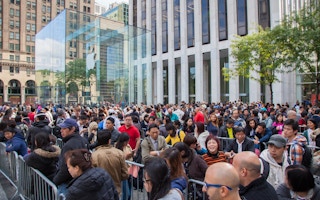“‘Buy! Buy!’ says the sign in the window. ‘Why? Why?’ says the junk in the yard.” - Paul McCartney, 1970
To continue reading, subscribe to Eco‑Business.
There's something for everyone. We offer a range of subscription plans.
- Access our stories and receive our Insights Weekly newsletter with the free EB Member plan.
- Unlock unlimited access to our content and archive with EB Circle.
- Publish your content with EB Premium.
Buy Me Once, a web portal launched earlier this year by former British advertising executive Tara Buttons, has been gaining global attention for a radical approach to shopping: Not only is its catalogue relatively limited, it comprises of long-lasting products you won’t need to replace.
From cookware to hair brushes to toys, the products have been selected for their longevity and quality, two characteristics of modern consumer goods that fell by the wayside when “planned obsolescence” took off as the favoured business model in the early 20th century.
As a strategy to overcome the Great Depression, the concept was the brainchild of Russian-German real estate broker Bernard London. By making products with deliberately shorter lifespans, he posited, manufacturers could encourage consumers to spend more, which he believed would lead to a rejuvenation of the economy.
The Great Depression ended in 1939, but London’s idea, it seems, lives on.
Today, mass consumption and shopping have become a way of life. From fast fashion to the next iPhone, consumers sometimes don’t even wait for something to break or wear down before replacing them.
Planned obsolescence has found a perfect partner in conspicuous consumption and together, they have created a culture where consumers favour what is “latest” and “on trend” over durable products with a classic design.
One could argue that the temporary nature of our relationship with consumer products, in particular tech gadgets, has a lot to do with the fact that technology often advances faster than product lifespans.
Necessity might be the mother of invention, but it is the desire for things that work better and competition to create the superior product that spurs on research and development. Without innovation, after all, there would be no human progress.
But this achievement has had significant consequences.
In the technology industry, for instance, chemicals used to make a wide array of products have turned landfills toxic and dangerous, and risked the health and lives of workers. Non-renewable resources such as copper and cadmium used in the production process have also been irreversibly depleted. -
These facts, however, remain but remote abstractions in the minds of consumers who give in to the appeal of new technology over environmental or ethical concerns.
Of course, it doesn’t help that a lot of modern products are made with less sturdy (read: cheaper) materials.
Plastic, for one, revolutionised consumer products when it ousted more traditional materials (such as wood, glass and metal) as the preferred medium for manufacturers. Production costs were dramatically reduced while the consumer market expanded with new goods, from containers to eyewear to furniture.
For a while, especially during the Pop Art movement (post World War II – 1970s), plastics enjoyed an exalted status, heralding in an age of modernity of more streamlined, shiny and lightweight possibilities and moving away from clunky, heavy designs.
“
But for all the convenience and savings it might have afforded, plastic is surely costing the planet more, in the form of pollution and wildlife devastation from non-biodegradable waste.
Because of its low cost and ubiquity, plastic - and the products made with it - came to be seen as cheap and disposable, and its lack of worth liberated consumers from upkeep and maintenance of the product or any kind of commitment to extend its use or lifespan.
But for all the convenience and savings it might have afforded, plastic is surely costing the planet more, in the form of pollution and wildlife devastation from non-biodegradable waste.
There is no better illustration of this than a finding by the Ellen MacArthur Foundation and the World Economic Forum released last month, where it estimates there will be more plastic than fish in the world’s oceans by 2050, with Asia accounting for 80 per cent of plastic leakage due to lax regulation.
The lure of affordable products that offer instant gratification and convenience is hard to resist, in the same way that the long-term (and already present) consequences of using environmentally harmful materials are easy to ignore.
For these reasons, the challenge to change consumer behaviour in a world used to cheap and abundant goods is a formidable one.
Buy Me Once is a notable effort to transform this pattern by giving consumers the information they need to overcome this vicious cycle of buying and replacing products.
And it is a insidious habit whose prices belie the truth: while many shoppers avoid paying for a higher-cost, higher quality product, they in fact often spend more by frequently replacing cheap, poorly made ones.
For a growing number of consumers who want to break out of this trap, Buttons’ website offers a plethora of sturdier products, encouraging a change from conspicuous consumption to a more conscious one.
As the company tagline says, the time is right to “throw away our throwaway culture”.
While items on the site are more expensive than their counterparts on the wider market, they come with a manufacturer’s guarantee that they would either last a lifetime or be easy to repair.
Take for example the Le Creuset brand that Buttons cites as the inspiration for the website. Established in France in 1925, their products come with a lifetime warranty, and the company will replace any product found with defects or poor workmanship.
One may balk at their prices (a one-litre capacity dutch oven goes for US$130), but then, customers would never have to buy another item like that again. Consumers pay more in the short run, but end up with better products and in turn, help the environment by reducing or even preventing waste.
In other words, this is the kind of shopping that won’t lead to McCartney’s lamentable “junkyard”.
And it isn’t just manufacturers and entrepreneurs like Buttons who want to make planned obsolescence, well, obsolete.
The French government passed legislation in March last year to protect consumers from shoddily-made products, making it mandatory for manufacturers of electrical appliances (including stoves, irons and mobile phones) to provide at least a two-year warranty on their products. They also have to ensure that parts be made available for repairs after the stipulated guaranteed period.
This is just one aspect on the wider push by the European Union to transition to a circular, zero-waste economy where resources, materials and end products are designed to be used in perpetuity in one form or another, eliminating waste altogether.
As the French legislation demonstrates, even when there may already be consumers ready to move on to more permanent relationships with their purchases, intervention from government can go a long way in encouraging a more sustainable marketplace.
Some may resist the idea of tampering with free market principles, but the reality is that we cannot afford to wait for the entrenched nature of present consumer behaviour to change in order to start fixing the damage that has already been done.











